Abstract
The U.S. Environmental Protection Agency (EPA) developed the concept of Water Quality Volume (WQv) as a Best Management Practice (BMP) to treat the first 25.4 mm of rainfall in urban areas, aiming to capture approximately 90% of annual runoff. However, applying this urban-based standard—designed for areas with over 50% imperviousness—to rural regions with higher infiltration and pervious surfaces may result in overestimated facility capacities. In Korea, a uniform WQv criterion of 5 mm is applied nationwide, regardless of land use or hydrological conditions. This study examines the suitability of this 5 mm standard in rural catchments using the Hydrological Simulation Program–Fortran (HSPF). Eight sub-watersheds in the target area were simulated under varying cumulative runoff depths (1–10 mm) to assess pollutant loads and runoff characteristics. First-flush effects were most evident below 5 mm, with variation depending on land cover. Nature-based treatment systems for constructed wetlands were modeled for each sub-watershed, and their effectiveness was evaluated using Flow Duration Curves (FDCs) and Load Duration Curves (LDCs). The findings suggest that the uniform 5 mm WQv criterion may result in overdesign in rural watersheds and highlight the need for region-specific standards that consider local land-use and hydrological variability.
1. Introduction
The United States Environmental Protection Agency (EPA) introduced the concept of Water Quality Volume (WQv) as a component of Best Management Practices (BMPs) for the mitigation of Nonpoint Source (NPS) Pollution [1]. WQv represents the design storage volume necessary to control the runoff of pollutants generated from a given drainage area. This standard typically targets the treatment of the first 1 inch (approximately 25.4 mm) of rainfall, which is estimated to capture approximately 90% of annual stormwater events in urban settings [1]. Design guidelines provided by the EPA and various state agencies generally assume a high level of imperviousness, often exceeding 50%, as a baseline condition for urbanized areas [1].
However, the direct application of these WQv-based design criteria to rural areas—where impervious surface cover is substantially lower—may result in overdesigned stormwater management facilities [2]. This reflects a key limitation in the current approach, namely, the insufficient consideration of land cover variability. Unlike urban regions, rural landscapes are predominantly pervious, which increases infiltration capacity and may significantly reduce actual runoff volumes. In addition, the rainfall-runoff characteristics specific to rural environments are not adequately incorporated into current WQv-based methodologies. Specifically, the initial abstraction and slower runoff response due to higher permeability in rural areas contrast sharply with the rapid runoff typically observed in urbanized settings [3,4,5,6].
In South Korea, Article 47 of the Enforcement Rules of the Water Environment Conservation Act stipulates design criteria for NPS control facilities, including standards for runoff treatment based on cumulative rainfall. This regulation mandates that the treatment capacity of such facilities be determined according to cumulative rainfall data to ensure effective design and operation [7]. Specifically, the application of a 5 mm cumulative runoff depth criterion in the design of NPS pollution control facilities is outlined in the “Guidelines for the Implementation of the National Subsidy Project for NPS pollution Reduction”. According to these guidelines, the WQv of such facilities must be designed to handle a minimum cumulative runoff depth of 5 mm.
This volume is calculated using the following Equation (2), which incorporates the cumulative runoff depth (P1) derived from the design rainfall and the drainage area (A) [8]. Since the value was originally developed based on urban conditions, applying the 5 mm cumulative runoff criterion to predominantly previous rural areas may lead to an overestimation of the required treatment capacity.
The EPA recommends applying WQv corresponding to a cumulative runoff depth of approximately 25 mm—intended to capture 90% of stormwater from initial rainfall events—or, alternatively, a minimum of 5 to 10 mm depending on regional characteristics.
In contrast, South Korea uniformly applies a 5 mm runoff depth criterion nationwide, which may not adequately reflect the diverse land-use types and precipitation patterns observed in rural regions.
Rural areas differ significantly from urban areas in terms of hydrological response characteristics, primarily due to lower impervious surface coverage and higher soil infiltration rates [9]. As a result, directly applying urban-designed Nonpoint Source (NPS) pollution control facilities to rural environments may be inappropriate. Previous domestic studies on NPS pollution have emphasized the necessity of region-specific management approaches and the importance of developing customized strategies that reflect the unique land cover and runoff behavior of rural catchments [10].
Recent research has further demonstrated that urban first-flush characteristics differ substantially from those observed in rural areas. In urban watersheds, the rapid runoff response and higher discharge volumes mean that the total rainfall amount becomes a dominant factor in determining the intensity of the first flush [11]. Also, other research proposed a modified method for more accurately calculating first-flush design flow rates, which could significantly contribute to the practical design of first-flush-based NPS control facilities. However, this approach has limited applicability, as it was primarily validated for small catchments with drainage areas of approximately 12 ha [12].
This study aims to evaluate the adequacy of the uniform 5 mm cumulative runoff (WQv) criterion currently applied to rural areas in Korea, focusing on hydrological and water quality aspects through the application of the HSPF model in the study area, which covers approximately 107.06 km2. It demonstrated through HSPF-based analysis of agricultural watersheds that pollutant load responses vary significantly depending on land-use type and storage capacity [13]. Furthermore, the EPA revised its Stormwater Calculator in 2023 to incorporate region-specific WQv design standards that reflect watershed characteristics [14]. These findings suggest that uniform criteria developed for urban conditions may be inappropriate for rural watersheds. Accordingly, this study conducted quantitative analyses of actual runoff characteristics and pollutant loads (T-P, kg/day) in rural catchments using the HSPF model under varying cumulative runoff conditions (1–10 mm). The simulation also compared runoff responses by land-use type, enabling the identification of appropriate WQv thresholds tailored to rural watershed conditions. Through this analysis, the study seeks to provide a scientific basis for establishing regionally customized NPS pollution control criteria in rural areas.
2. Methodology
2.1. Study Area
The study area was selected based on the following criteria: it represents typical characteristics of rural NPS pollution, exceeds regulatory standards for river and water quality, features gentle slopes, and is located in an upstream region free from interference by environmental infrastructure. These conditions indicate a high need for NPS pollution management. The selected study area is the Songya Stream watershed in Andong City, South Korea. The watershed originates in Pyeongon-myeon, Yeongju-si, Gyeongsangbuk-do, and terminates in Bukhu-myeon, Andong-si. It covers a catchment area of approximately 107.06 km2 with a stream length of 23.3 km.
Hydrologically, the Songya Stream sub-basin is part of the mid-reach area downstream of the Andong Dam. The stream flows through Byeonbyeon Stream, a local river, and ultimately joins the Nakdong River. Although the upper reaches of the Nakdong River and Byeonbyeon Stream are significantly influenced by regulated flows from the Andong Dam and Imha Dam, respectively, the Songya Stream watershed itself is hydrologically independent of direct dam influences. The area is predominantly rural, lacks basic environmental infrastructure, and demonstrates a high necessity for NPS pollution control. In accordance with Article 54 of the Water Environment Conservation Act, the area was officially designated in 2018 as a NPS pollution management zone specifically aimed at mitigating rural NPS pollution. Within the target flow range of 10–60% during rainfall events, the region is required to achieve a water quality goal of TP ≤ 0.2 mg/L [15].
For the meteorological input data, daily precipitation records from 2011 to 2024 were obtained from the Andong synoptic weather station (ASOS). The station was selected based on its spatial proximity to the study area, serving as the most representative source within the watershed domain. All spatial analyses and maps were created using ArcGIS (ESRI) with the GCS_Korean_Datum_1985 coordinate system.
Figure 1 presents the Thiessen network and the corresponding spatial extent of the study area. The Thiessen network was delineated using ESRI ArcGIS, and the coordinate system applied was GCS_Korean_Datum_1985.
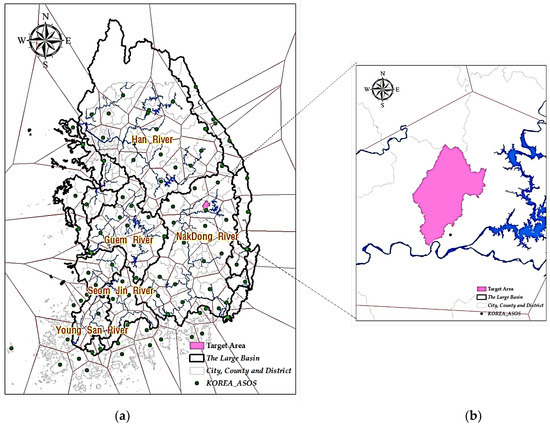
Figure 1.
Location of the study area and meteorological station: (a) Geographic location of the Songya Stream watershed in Korea (b) Detailed map of the Songya watershed with the An dong synoptic weather station.
2.2. Model Setup
A Digital Elevation Model (DEM) at a scale of 1:25,000 was utilized to discretize the study area into a grid-based representation of the terrain. This model consists of numerical data arranged at regular intervals, representing the elevation of geographic locations. For this study, elevation data provided by the National Geographic Information Institute (NGII) were converted from IMG format into a GRID format with a spatial resolution of 10 m × 10 m, as illustrated in Figure 2. This DEM was used to analyze the topographic characteristics of the watershed and to delineate sub-watershed boundaries.
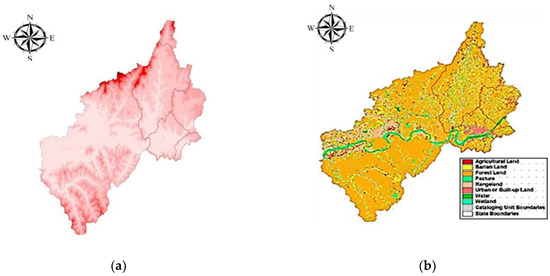
Figure 2.
DEM and Land-Use Map of the Study Target Area as (a) DEM (b) Land-Use Map.
For input to the HSPF model, DEM data at a scale of 1:5000 were obtained from the NGII. Land-use data were acquired from the Ministry of Environment (MOE) at a scale of 1:25,000. Meteorological data from the Andong Meteorological Station were collected for the period 2006–2024. These data were obtained from the Korea Meteorological Administration (KMA) and include daily and hourly records of precipitation, average temperature, relative humidity, solar radiation, wind speed, and cloud cover, among others [16]. Figure 1b shows the location of the ASOS relative to the boundary of the Songya Stream watershed. To confirm the spatial representativeness of the meteorological data, a Thiessen polygon analysis was performed. This analysis verified that the Andong station is located within the watershed and that no other meteorological stations offering long-term records were available nearby. Therefore, data from the Andong station were used as the representative meteorological input for the HSPF model. The caption of Figure 1 was also revised to clearly reflect the geographic context and the spatial role of each subfigure.
Streamflow data were sourced from the MOE’s Water Management Information System (WAMIS), which provided 8-day and monthly flow data from both automated and manual monitoring stations, as well as data from Water Quality Monitoring Networks. Water quality data were also obtained from the MOE and the Environmental Management Office based on 8-day/month monitoring intervals [17]. Monitored parameters included water temperature, dissolved oxygen (DO), biochemical oxygen demand (BOD), total nitrogen (TN), and total phosphorus (TP), using data from the National Water Quality Monitoring Networks. As for the flow and water quality data used for validation and calibration, those obtained twelve times during rainfall in 2020~2021 from two mainstream points and eight tributary points in the Songya watershed were used.
Pollution source data were derived from the MOE’s National Pollution Source Survey. Water intake and withdrawal data were collected on a daily and monthly basis from local governments and WAMIS [18], including information from intake and pumping stations within the target reservoir watershed. Watershed boundaries and unit watershed delineations were defined using maps provided by the MOE.
To enhance clarity regarding the spatial and temporal characteristics of the input datasets, we have added a newly structured Table 1 that summarizes the sources, scales, and contents of the hydrological, meteorological, and water quality data used in the HSPF model. Streamflow and water quality data were collected from seven long-term monitoring stations within the Songya watershed (Figure 2a) from 2010 to 2024 and were used as continuous input to the model. Additionally, event-based monitoring was conducted twelve times across 2020 and 2021 at eight points (Figure 2b), where Points 1 and 8 represent the mainstream, and Points 2 through 7 represent individual tributaries. These high-resolution datasets were used to supplement model validation and to reflect first-flush effects. Meteorological input data, including precipitation, air temperature, solar radiation, humidity, and wind speed, were obtained from the Andong synoptic weather station (Figure 1b), and recorded at daily and hourly intervals.

Table 1.
The model input data.
The monitored water quality parameters include water temperature, DO, BOD, TN, TP, and turbidity, as detailed in Table 1. These parameters were applied consistently during both the calibration period (2013–2017) and the validation period (2018–2024). While both BOD and TP are commonly used as water quality regulatory indicators in Korea, this study primarily focused on TP due to its higher relevance in rural NPS pollution management. TP is widely considered the key target pollutant in agricultural catchments and has been frequently used as the primary indicator in prior studies [19,20,21,22].
For model calibration and validation, observed streamflow and water quality data from general monitoring stations operated by the MOE were used. As shown in Figure 3, input data were collected from a total of seven monitoring stations. This section may be divided by subheadings.
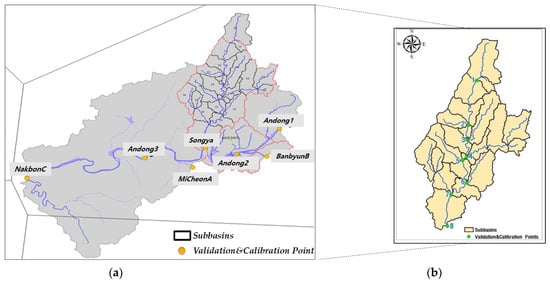
Figure 3.
Monotirong Locations and HSPF Model Setup for the Songya Watershed as: (a) Lomg-term monitoring sta tions (b) Event-based monitoring points.
2.3. Calibration and Validation
The results of model calibration and validation were evaluated using the percent difference (% Difference), which represents the discrepancy between observed and simulated values, in accordance with the criteria proposed by the US EPA (2011) and Donigian (2002) [22,23,24]. The percent difference was calculated using Equation (1) below. For the calibration and validation of watershed hydrology, the coefficient of determination (R2) was additionally used as an evaluation metric, and the assessment criteria presented by Donigian (2002) and the US EPA (2011) were also applied [23,24].
The streamflow calibration period was set from 2013 to 2017, and the validation period from 2018 to 2024. During the calibration phase, the %Difference at the downstream point of Songya Stream was evaluated as “Very Good”, and the R2 value was rated as “Good”. For station Nakbon-C, the %Difference was rated as “Good”, and R2 as “Very Good”. During the validation period, both %Difference and R2 at Nakbon-C were evaluated as “Very Good,” indicating that the model simulations reasonably reflect the observed measurements. The evaluation criteria are summarized in Table 2 [25,26].

Table 2.
General Calibration/Validation Target or Tolerances for HSPF applications.
2.4. Calculation of Appropriate Cumulative Runoff Depth and Development of Suitable Scenarios in Rural Areas
WQv is used in the design of NPS pollution control facilities. WQv refers to the capacity of a facility to store and treat stormwater runoff. In most regions of the United States, the standard rainfall used to calculate WQv is set between 0.5 and 1.5 inches. However, in South Korea, the NPS pollution Control Manual and the installation reporting system use a WQv corresponding to a cumulative runoff depth of 5 mm. This is calculated as shown in Equation (2). Equation (2) converts the local rainfall into cumulative runoff depth to ensure that the designed rainfall is capable of treating at least 5 mm of runoff.
P1: Design rainfall converted into accumulated runoff
A: Drainage area
In South Korea, the Water Environment Conservation Act determines the design scale and capacity of NPS pollution control facilities through the analysis of rainfall frequency, runoff volume, and pollution load, and it is converted into cumulative runoff depth to ensure that at least 5 mm of rainfall can be treated. Recently, the MOE presented Equations (2) and (3) in the NPS pollution Control Facility Manual (2022), which is the most widely used method.
Equation (2) converts the cumulative runoff depth of the drainage area to ensure that the facility can handle a rainfall depth of at least 5 mm. The capacity of the facility is calculated based on the design rainfall and the size of the drainage area. The design capacity WQv of the facility is calculated as presented in Equations (2) and (3) of this study. The cumulative runoff depth in both equations is approximately 5 mm, which is based on results cited from the US EPA and is selected for urban areas where the impervious area of the drainage area is greater than 50%. Therefore, when applied to rural areas with mixed land uses or larger permeable areas, there is a risk of overestimation or underestimation of the facility’s required capacity. This is because rural NPS pollution, influenced by various land uses, cannot be adequately quantified with only the 5 mm criterion.
A scenario for the existing capacity calculation formula was developed, and the study was conducted using the HSPF model for the target area. The scenario was created by adjusting the land-use area ratio of the total area and applying cumulative runoff depths ranging from 1 to 10 mm in 1 mm increments. However, for the capacity calculation in this study, the drainage area used was based on the area of each sub-watershed within the target region. The cumulative runoff depth was applied in 1 mm intervals, ranging from 1 mm to 10 mm, across the seven sub-watersheds. The HSPF model’s BMP module was used to apply the capacity (m3) based on changes in runoff depth (mm), and the facility was modeled with a natural retention function.
As shown in Figure 4, when applying the facility, the model manages the runoff pathways, and the water quality model involves creating a virtual stream in the lower part of the watershed where the NPS pollution control facility is installed. Subsequently, the flow corresponding to the facility’s capacity is collected, conveyed through the virtual stream, treated, and then discharged into the main river [25]. This process was primarily carried out by generating a separate MASS LINK. In rural or low-density development areas, where NPS pollutants such as nutrients and organic matter are abundant due to the runoff characteristics, a natural mechanism-based NPS pollution control facility was applied. Therefore, following the guidelines for the operation of NPS pollution control facilities and their manuals, a natural facility (constructed wetland) was used [26].
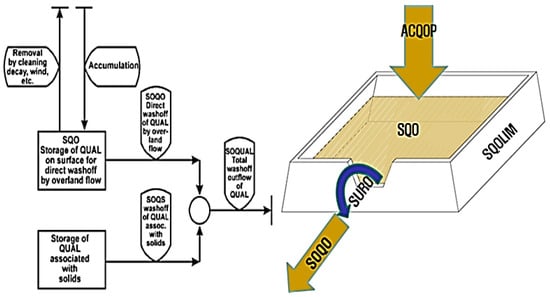
Figure 4.
Reflection Method in HSPF as an Example of a Simulation Structure of Surface Spill in a Pitcher/Unpermeable.
To manage NPS pollution, an appropriate capacity was applied to the natural facilities, and the pollution sources and non-structural management measures were incorporated to develop the final scenario. The study area is a representative rural region, and for comprehensive planning, fertilizer management, and drainage channel management were proposed as management strategies [27]. In this context, the capacity of the natural facility was determined by applying the optimal cumulative runoff depth derived from the results of this study.
2.5. Appropriate Evaluation Method
In this study, TP and BOD were selected as the primary water quality indicators. While TN and TSS were initially considered, they were excluded from the final analysis due to limited data availability and inconsistent monitoring across the sub-watersheds. TP and BOD had the most comprehensive and consistent datasets, enabling reliable calibration and validation of the HSPF model. Moreover, TP is designated as the key regulatory indicator for NPS pollution management in the Songya Stream watershed, and BOD is widely used as a proxy for organic pollution. Therefore, the selection aligns with both data feasibility and national policy objectives of South Korea [28].
The effectiveness of the facility was evaluated by assessing the results before and after its application at the downstream points of the target area, where each sub-watershed converges. The evaluation was based on the improvement in water quality and pollutant load in the river of the target area, using the Flow Duration Curve (FDC) and Load Duration Curve (LDC).
The FDC, also known as the Duration Curve (DC), was used to sort daily flow data from the maximum to the minimum flow. Each measurement was then expressed as a percentage according to Equation (4). The X-axis represents the flow duration time (%) and the Y-axis corresponds to the flow rate (m3/s). These FDCs are important tools for analyzing long- and short-term flow variations in river basins, as well as identifying factors influencing water quality changes [26]. The equation used is shown in Equation (4).
The FDC is divided into five stages based on hydrological conditions: 0–10% for High Flows, 10–40% for Moist Conditions, 40–60% for Mid-Range Flows, 60–90% for Dry Conditions, and 90–100% for Low Flows. In Korea, the classification is based on the duration of high flow, with categories such as Flood Volume, Abundant Flow (over 95 days per year, exceeding a probability of 26.0%), Ordinary Flow (over 185 days, with a probability of 50.7%), Low Flow (over 275 days, with a probability of 75.3%), and Drought Flow (over 355 days, with a probability of 97.3%).
The LDC is a curve that represents the relationship between observed water quality data and overall flow conditions. By using water quality data under various flow conditions, the LDC visually depicts the observed water quality and flow during specific periods, enabling an analysis of the distribution of observed values across the entire flow spectrum. This method helps identify the necessary flow and water quality categories for effective river and watershed management. A duration curve is a graphical representation of the percentage of time during which a given flow or load parameter exceeds or is equal to a specified value. Additionally, it can be used to evaluate the distribution of nonpoint and point sources of pollution, seasonal water quality impacts, allowable pollutant loads, load reductions, exceedance frequencies, and compliance with water quality standards. The creation of the Load Duration Curve involves the use of daily flow data and water quality data, calculating the pollutant load using Equation (5), which is then used to generate the curve. The equation is shown as Equation (5)
To construct a representative LDC, it is necessary not only to have a representative FDC but also to define target water quality standards for pollutants. The target water quality for the study area is set to the ordinary (III) grade for riverine environmental quality, with a Total TP concentration of 0.2 mg/L, as outlined in the [29]. The cumulative runoff depth of 5 mm for each sub-watershed area is applied to the HSPF model, and LDCs are constructed before and after the implementation of the facility.
Subsequently, the effectiveness of the facility is evaluated using the results from the graph, which are analyzed through the following Equation (6). The effectiveness assessment in Equation (6) evaluates the water quality and pollutant load in the river before and after the facility implementation.
3. Results and Discussion
3.1. Model Validation and Calibration
The flow calibration period was set from 2013 to 2017, while the validation period was set from 2018 to 2024. As shown in Figure 5, the Songyacheon station generally showed a performance level of Very Good to Good, while Nakbon C was consistently evaluated as Very Good.
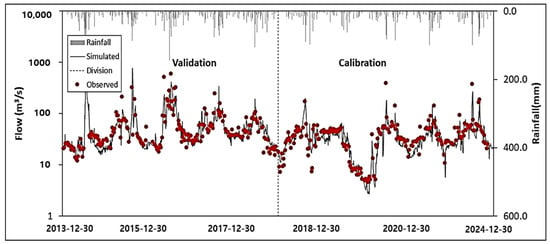
Figure 5.
Songyacheon Station Flow Calibration and Validation.
The water quality calibration period was set from 2013 to 2017, and the validation period was set from 2018 to 2024. As shown in Figure 6, the water quality evaluation parameters temperature, DO, BOD, T-N, and T-P were assessed. The Songyacheon station generally showed a performance level ranging from Very Good to Good.


Figure 6.
Songyacheon Water Quality Calibration and Validation.
During the calibration process, BOD and TP showed stable and accurate simulation performance, supported by sufficient observed data. On the other hand, attempts to simulate TN and TSS using the HSPF model resulted in unstable outputs, primarily due to data gaps and low temporal resolution. To ensure model reliability and minimize uncertainty, these parameters were not included in the final scenario analysis.
3.2. Determination of Appropriate Cumulative Runoff and Development of Suitable Scenarios in Rural Areas
At the downstream section of Songyacheon, the analysis assessed changes in water quality and pollutant loads before and after the implementation of facilities, based on variations in cumulative runoff volume (m3). Since the downstream of Songyacheon is the final confluence point of sub-watersheds 1 through 7, the capacity applied for each sub-watershed based on cumulative runoff was evaluated by comparing water quality and pollutant load before and after facility application.
The Songya8 site is located at the downstream confluence point where all sub-watersheds (Songya1 to Songya7) merge, thereby serving as a hydrologically integrated location. This site reflects the cumulative effects of upstream land-use and pollutant contributions, making it a representative monitoring point for evaluating overall watershed water quality conditions.
Based on site-specific monitoring data collected during rainfall events, the Event Mean Concentrations (EMCs) of key pollutants at the Songya8 monitoring point were observed as follows SS 21.1~935.1 mg/L, BOD 0.5~9.2 mg/L, TOC 4.4~61.2 mg/L, TN 4.070~9.000 mg/L, TP 0.240~1.700 mg/L.
Furthermore, a Pearson correlation analysis conducted at Songya8 revealed strong positive relationships among TP, turbidity, SS, BOD, and TN, with an average Pearson correlation coefficient (r) of 0.57 (range: 0.26–0.95). Cluster analysis also grouped these parameters together. These results support the use of TP as a scientifically valid proxy for integrated water quality assessment and justify its selection as the primary representative pollutant for modeling and scenario development in this study.
To assess the potential impact of input variability on model performance, a preliminary sensitivity analysis was conducted using the SPSS (version 29.0) statistical software. This analysis aimed to identify how fluctuations in key inputs and parameters might influence the estimation of pollutant loads, thereby supporting the robustness of the scenario-based results. Specifically, core rainfall variables such as total precipitation and average rainfall intensity, as well as major HSPF parameters (e.g., pollutant build-up rates and wash-off coefficients), were systematically varied within a range of ±10–20%. The corresponding changes in TP and BOD loads were evaluated using SPSS. The analysis revealed that TP load estimates fluctuated by up to approximately ±15%; however, the overall loading trends and the contribution patterns associated with agricultural land use remained statistically stable. BOD load estimates showed comparatively lower sensitivity, likely due to dilution effects during rainfall and natural instream self-purification processes. In terms of NPS contributions, TP demonstrated a strong positive correlation with agricultural land area, with a Pearson correlation coefficient of r = 0.930. In contrast, BOD exhibited weaker correlations with source-specific generation rates, which may reflect the influence of instream attenuation and rainfall dilution. Among the various influencing factors—including topography, meteorology, and pollutant sources—topographic parameters such as slope and elevation difference exhibited the highest correlation with pollutant loads in the Songya Stream watershed. In the case of meteorological drivers, total rainfall depth and average intensity were identified as the most critical variables affecting load estimates.
Although this study focused primarily on scenario-based assessments of pollutant reduction, these preliminary findings provide confidence in the stability of the model outcomes. Future research should consider implementing quantitative uncertainty analysis techniques (e.g., Monte Carlo simulation or parameter perturbation methods) to further enhance the reliability of predictions.
As cumulative runoff increased, the total capacity (m3) also increased, with BOD showing convergence at a cumulative runoff of 8 mm and TP at 9 mm. BOD showed a decreasing improvement effect with smaller rainfall events compared to TP due to the dilution effect of natural self-purification in the river. Furthermore, the reduction in pollutant load (kg/day) with facility application showed a 60% improvement for BOD and 80% for TP compared to the pre-application levels as shown in Table 3.

Table 3.
WQv Results of Capacity Application of Facilities in accordance with Cumulative Outflow Change (Final confluence point of Songyacheon Stream).
The results based on the changes in cumulative runoff indicate that BOD (mg/L) reaches 1.0 when cumulative runoff exceeds 5 mm, while TP reaches similar values at 6 mm. For pollutant load, BOD exceeds 6 mm and TP exceeds 10 mm, showing improvement effects similar to those of WQv. However, under conditions where cumulative runoff is below 5 mm, the difference in the improvement effects on water quality and pollutant load was most pronounced when the cumulative runoff was at 1 mm. Specifically, the improvement effects on water quality were BOD 24.9% and TP 32.4%, while for pollutant load, the improvements were BOD 26.2% and TP 31.9%. Therefore, since the cumulative runoff of 5 mm, where BOD begins to converge, shows similar improvement effects on water quality and pollutant load to those calculated by the existing method, it is suggested that this relationship is suitable for use in capacity calculation at a cumulative runoff of 5 mm.
At the confluence of all the tributaries in the lower reaches of Songyacheon, a cumulative runoff of 5 mm was found to be appropriate. However, when analyzed by sub-watershed, only Songyacheon 6 and Songyacheon 7 were able to sufficiently reduce the BOD and TP pollutant loads with a capacity calculated at 3 mm (Figure 7). As cumulative runoff volume increases, pollutant loads tend to decrease. However, from 3 mm onwards, the reduction in load becomes less significant, with values at 5 mm appearing similar. This indicates that the 5 mm threshold may not necessarily be optimal and highlights the need for a more refined, site-specific criterion based on cumulative runoff analysis. Table 3 presents the land-use area per unit area by sub-watershed. The pervious area was calculated to include paddy fields, dry fields, and forests, while the impervious area was presented as the area of built-up land. The ratios of pervious and impervious areas were shown for each sub-watershed as the proportion of total area, and as a result, Songyacheon 6 and 7 were identified as sub-watersheds with the lowest proportion of impervious areas. On the other hand, Songyacheon 1 had the highest proportion of impervious areas. The appropriate capacity for Songyacheon 1 was found to be 5 mm of cumulative runoff. These results suggest that, despite the same rainfall, the size of the required capacity and the effectiveness of the facility in reducing pollutant loads can vary depending on the characteristics of land use. Based on the land-use characteristics of each sub-watershed, differences in optimal cumulative runoff thresholds were identified. Specifically, Songya6 and Songya7, which are dominated by highly pervious land cover such as forests and paddy fields, showed sufficient improvements in BOD and TP loads with a 3 mm runoff threshold. In contrast, Songya1, with relatively higher impervious surfaces including residential and road areas, required a minimum of 5 mm to achieve comparable reductions. Songya3 and Songya4, where agricultural land use exceeded 33%, demonstrated optimal runoff thresholds between 4 and 5 mm due to increased runoff volumes as shown in Table 4. These variations indicate that land cover and imperviousness are key factors influencing the response of pollutant load reductions [20,21] These findings align with previous studies that emphasize the role of land cover and infiltration capacity in shaping first-flush behavior and pollutant transport dynamics in rural watersheds [20,22].
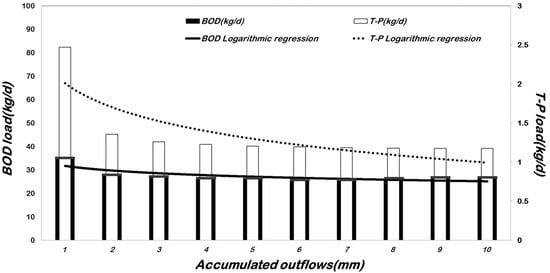
Figure 7.
WQv Results of Capacity Application of Facilities in accordance with Cumulative Outflow Change (Final confluence Songya8 point of Songyacheon Stream).

Table 4.
Ratio and Ranking of Land-Use Area.
3.3. Appropriate Evaluation
In this section, FDCs for the last 10 years (2010–2020) were developed for the seven sub-watersheds in the Songyacheon watershed. The black line in Figure 8 represents the target standard for the middle management region, which is the river environmental living standard of Class III. The management target for the Songyacheon watershed (hereafter referred to as the NPS pollution Control Area of Songyacheon) is based on a TP concentration of 0.2 mg/L, and the corresponding standard pollutant load (kg/day) is shown. The cumulative runoff of 5 mm for each sub-watershed area was applied to the model HSPF to generate LDC before and after the installation of the facility. The gray line represents the pollutant load before the facility was applied, and the red line shows the pollutant load after the facility was applied.
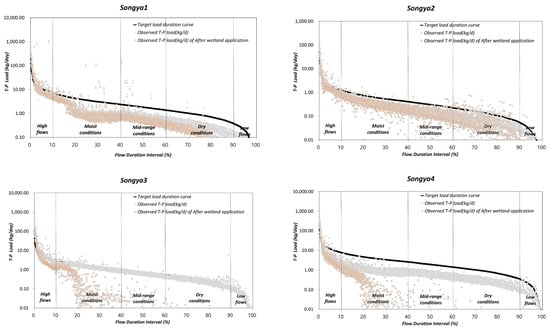
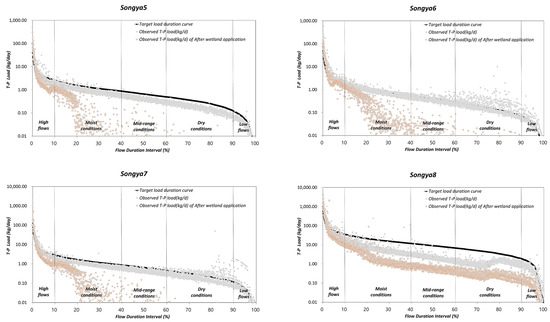
Figure 8.
Songya watershed WQv application of TP (kg/d) (’10~’20).
Within the 10–60% flow interval—where NPS pollution exerts the greatest influence in the Songya Stream watershed—water quality significantly improved after the implementation of pollution reduction measures. Specifically, BOD and TP concentrations improved by 50.3% and 67.0%, respectively, while pollutant loads were reduced by 43.6% for BOD and 63.0% for TP. When evaluated using WQv as a design criterion, water quality improved by 50.3% for BOD and 75.6% for TP, and pollutant loads decreased by 56.4% for BOD and 76.4% for TP. These improvements indicate that the management target of 0.2 mg/L for TP is achievable within the management flow interval (10–60%).
An analysis of TP concentration changes across different flow intervals was conducted to evaluate the degree of improvement. TP has been identified as a key target pollutant in the designated NPS pollution management area of the Songya watershed. Water quality was assessed at the Songya8 monitoring site, located at the downstream confluence where all tributaries merge. Prior to the implementation of the facilities, TP concentrations at the Songya8 site during high-flow events (0–10%), which are most affected by rainfall, ranged from a minimum of 0.100 mg/L to a maximum of 0.500 mg/L. As shown in Figure 8, these values frequently exceeded the general water quality threshold of 0.2 mg/L for streams.
Figure 9 presents the final T-P concentrations after the implementation of pollutant reduction facilities. Given the significant correlation between flow rate and pollutant concentration, the results were categorized by flow rate intervals to more accurately assess the treatment effectiveness under varying hydrological conditions.
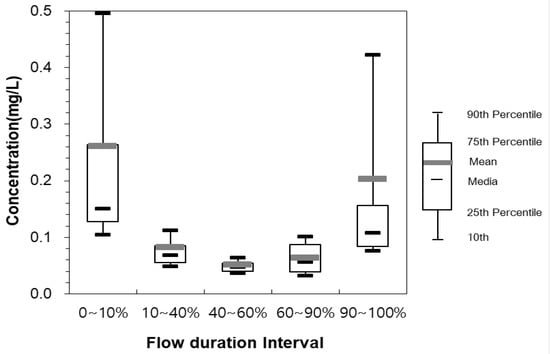
Figure 9.
T-P Concentration Changes with Flow Rate at Songyacheon-8.
While TP concentrations during the 10–90% flow interval appeared to meet the 0.2 mg/L target, an increasing trend in TP was observed during low-flow conditions (90–100%). After applying facilities designed using WQv, TP concentrations at the Songya8 site during the high-flow interval (0–10%) ranged from 0.015 mg/L to 0.350 mg/L, indicating a maximum improvement of approximately 30.5% compared to pre-implementation conditions. Particularly in the 10–60% flow interval, TP concentrations improved from a maximum of 0.150 mg/L to 0.020 mg/L, demonstrating a substantial positive impact on stream water quality. However, in the 40–60% flow range, TP concentrations tended to remain higher than in other intervals, suggesting that the effectiveness of water quality improvement may vary depending on specific flow conditions.
To quantitatively assess the variations in pollutant concentration and load across different flow conditions, an LDC analysis was conducted. The results showed that both BOD and TP exhibited the most significant improvements—ranging from 50% to 75%—within the 10–60% flow interval, which corresponds to the early to mid-range flow conditions following rainfall events.
In particular, substantial reductions in pollutant concentrations were observed when the cumulative runoff depth was below 5 mm. Beyond this threshold, the rate of improvement began to converge, indicating a diminishing marginal effect. This trend reflects the typical characteristics of first-flush dynamics, wherein a large portion of pollutants is rapidly mobilized during the initial stages of runoff, followed by dilution and increased contributions from baseflow as rainfall continues.
These findings are consistent with previous studies, which reported that in rural watersheds, the first-flush effect is most prominent within a rainfall depth range of 3–5 mm [22]. The convergence of BOD and TP concentrations in our HSPF simulation around the05 mm cumulative runoff depth reinforces the physical plausibility of this threshold and highlights the natural self-purification processes in rural settings, such as vegetated cover and permeable soils.
Therefore, this study demonstrates that first-flush dynamics are most evident below 5 mm of cumulative runoff, and that subsequent increases in rainfall volume primarily lead to dilution and groundwater contributions. These patterns validate the modeling results and support the scientific rationale behind the 5 mm WQv design criterion used for rural NPS pollution management. The related graph is presented in Figure 9.
First, the application of nature-based low-impact development (LID) facilities was considered. Based on the cumulative runoff depth results of 5 mm derived in the previous section, design volumes were calculated using Equation (2) and applied to each sub-watershed using the previously calibrated HSPF model.
Second, a management strategy for promoting the use of low-solubility fertilizers was introduced. These fertilizers contain fewer potential pollutants compared to conventional fertilizers and exhibit lower runoff during rainfall events. Fertilizer application management was implemented in upland fields located within 200 m of the study area, covering a total area of 195.2 hectares. The spatial application of this measure is illustrated in Figure 10 and Table 5.
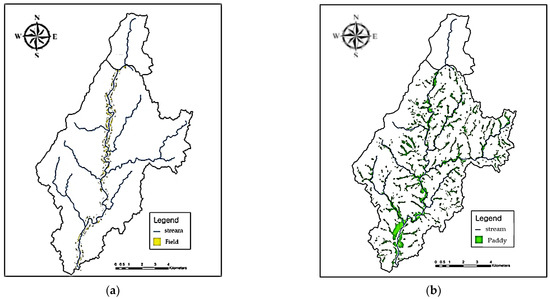
Figure 10.
Fertilizer Management and Drainage Ditch Management as (a) Fertilizer Management and (b) Drainage Ditch Management.

Table 5.
Management for NPS pollution.
Third, drainage gate management was applied. This approach involves adjusting the height of drainage gates installed in paddy fields to control water outflow. The objective is to enhance the water retention capacity of paddies during rainfall, thereby reducing NPS pollutant loads. Based on previous research, approximately three gates per hectare are required. The total paddy field area in the study region amounts to 1112.4 hectares, and the increase in gate height was set at 5 cm compared to conventional practices. The implementation details are shown in Figure 10 and Table 4.
As a result of the model simulation, Figure 11 illustrates whether the water quality target was exceeded at the terminal point of the Songya Stream watershed, designated as the Songya 8 monitoring site, using an LDC analysis. In the pre-application condition (Figure 11a), most of the pollutant loads exceeded the target criteria. However, when NPS pollution reduction facilities were applied in the study area and reflected in the model, the results indicated that water quality standards could be met during high-flow events beyond the top 5% of flow duration due to effective runoff management.
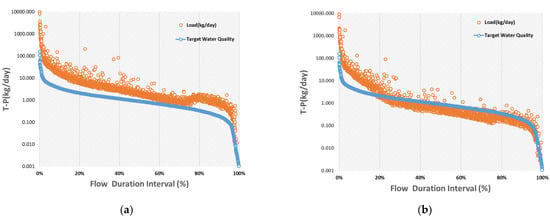
Figure 11.
LDC of the Final confluence Songya8 point of Songya Stream as (a) Before NPS management Application (b) After NPS management Application.
Within the target management flow range of 10–60%, the average concentration of TP improved from 0.068 mg/L before implementation to 0.025 mg/L after, reflecting an approximate 63.2% reduction. Likewise, the TP load decreased from 5.810 kg/day to 2.541 kg/day, showing an improvement of 56.3%.
This study conducted HSPF modeling for the Songya Stream watershed, incorporating the region’s actual hydrological, topographical, and land-use characteristics. The results confirmed that the 5 mm cumulative runoff criterion is appropriate for achieving water quality improvement in this particular watershed. However, this standard was originally established based on urban U.S. conditions with high impervious surface ratios (exceeding 50%) [20], and thus, its uniform application to rural or mixed-use watersheds presents clear limitations.
The Songya watershed is a typical rural catchment, characterized by 62.3% forest, 26.5% agricultural land, and only 3.0% built-up (impervious) areas. Therefore, the findings of this study should be interpreted as simulation results optimized for these specific watershed conditions. To generalize these findings to other regions, additional verification and calibration that account for region-specific hydrological, topographical, and land-use characteristics are necessary.
4. Conclusions
This study evaluated the effectiveness of BMPs in improving water quality and reducing pollutant loads (BOD and TP) based on cumulative runoff depth in the downstream region of the Songya Stream watershed, where seven sub-catchments converge. As cumulative runoff depth increased, the required BMP volume also increased, with BOD and TP showing convergence trends at 8 mm and 9 mm, respectively. BOD improvement occurred at lower runoff depths due to natural attenuation within the stream. A threshold of 5 mm was identified as appropriate, beyond which additional improvements were marginal.
Sub-watershed analysis indicated that 3 mm of cumulative runoff was sufficient for areas with high perviousness (Songya 6 and Songya 7), while 5 mm or more was required in highly impervious areas such as Songya 1. Over a 10-year period, BMP implementation resulted in average improvements of 50.3% (BOD) and 75.6% (TP) in water quality, and 56.4% (BOD) and 76.4% (TP) in load reduction, particularly within the flow duration interval of 10–60%. The water quality target of TP ≤ 0.2 mg/L was achieved in most flow conditions.
Furthermore, an integrated management scenario—including (1) nature-based facilities, (2) slow-release fertilizer application, and (3) paddy drainage gate control—demonstrated that the water quality standard could be maintained during rainfall events. In the target management flow range (10–60%), TP concentration improved from 0.068 mg/L to 0.025 mg/L (a 63.2% reduction), and TP load decreased from 5.810 kg/day to 2.541 kg/day (a 56.3% reduction). These findings suggest that a 5 mm runoff threshold is a rational design basis for BMP capacity, and that land-use-specific, differentiated strategies are essential for effective NPS pollution management.
Author Contributions
Conceptualization, J.K.; Validation, J.K.; Investigation, J.K. and O.Y.C.; Resources, O.Y.C.; Writing—review & editing, J.K. All authors have read and agreed to the published version of the manuscript.
Funding
This research received no external funding.
Data Availability Statement
The original contributions presented in this study are included in the article. Further inquiries can be directed to the corresponding author(s).
Conflicts of Interest
The authors declare no conflict of interest.
References
- U.S. EPA. National Menu of BMPs for Stormwater; U.S. EPA: Washington, DC, USA, 2023. Available online: https://www.epa.gov/npdes/national-menu-best-management-practices-bmps-stormwater (accessed on 24 April 2025).
- Shin, J.Y.; Lee, J.S.; Jeon, J.H.; Shin, M.H.; Choi, J.D. Problems and Improvement of Reduction Facility at the NPS Pollution Management Area. In Proceedings of the Korean Society of Agricultural Engineers Conference, Naju, Republic of Korea, 22–23 October 2015; p. 270. [Google Scholar]
- Jeon, M.; Kim, B.; Lee, E.; Song, J.; Kim, J. Long-Term Monitoring of an Urban Stormwater Infiltration Trench in South Korea with Assessment Using the Analytic Hierarchy Process. Water 2022, 14, 3529. [Google Scholar] [CrossRef]
- Lee, S.; Kim, J.H.; Kim, H.; Kim, J.Y. Recent Progress in Low-Impact Development in South Korea: Water-Management Policies, Challenges and Opportunities. Water 2018, 10, 435. [Google Scholar] [CrossRef]
- MOE, Republic of Korea. Guidelines for the Implementation of Nonpoint Pollution Reduction Projects with National Subsidies; MOE: Sejong, Republic of Korea, 2024; Available online: https://clik.nanet.go.kr/ (accessed on 24 April 2025).
- National Institute of Environmental Research (NIER). A Study on the Characteristics and Reduction Measures of NPS Pollution in Rural Areas; NIER: Incheon, Republic of Korea, 2022. [Google Scholar]
- MOE, Republic of Korea. Enforcement Rule of the Water Environment Conservation Act; MOE: Sejong, Republic of Korea, 2025; Available online: https://www.law.go.kr/LSW/eng/engLsSc.do?menuId=1&query=Water%20Environment%20Conservation%20Act (accessed on 24 April 2025).
- MOE, Republic of Korea. Guidelines for Promotion of Nonpoint Pollution Reduction State Subsidies; MOE: Sejong, Republic of Korea, 2024; Available online: http://me.go.kr (accessed on 24 April 2025).
- Ministry for Food, Agriculture, Forestry and Fisheries. Guidelines for Nonpoint Source Pollution Management in Rural Areas; Ministry for Food, Agriculture, Forestry and Fisheries: Seoul, Republic of Korea, 2007; Available online: https://www.opm.go.kr (accessed on 4 June 2025).
- Jeon, J.J.; Kim, Y.; Park, S.Y.; Choi, M.J. Trends in Nonpoint Source Pollution Research and Future Directions in Korea. J. Korea Soc. Environ. Technol. 2018, 19, 1–13. [Google Scholar]
- Zhang, Y.; Yu, M.; Li, Y.; Wang, Q.; Liu, Z. New conceptualization and quantification method of first-flush in urban runoff. Sci. Total Environ. 2023, 891, 162020. [Google Scholar] [CrossRef]
- Froehlich, D.C. A Modified Rational Method Approach for Calculating First Flush Design Flow Rates to Mitigate Nonpoint Source Pollution from Stormwater Runoff. Hydrology 2024, 11, 21. [Google Scholar] [CrossRef]
- Chen, L.; Wu, L.; Li, H.; Zhang, Q. Evaluation of BMPs in Reducing Agricultural Runoff Pollution Using HSPF in a Typical Watershed in China. J. Environ. Manag. 2021, 284, 112021. [Google Scholar]
- U.S. EPA. National Stormwater Calculator: Updated with Regionally Tailored BMP Design Parameters; EPA Office of Research and Development: Washington, DC, USA, 2023. Available online: https://www.epa.gov/water-research/national-stormwater-calculator (accessed on 1 June 2025).
- MOE, Republic of Korea. Water Environment Conservation Act, Article 54. Available online: https://www.law.go.kr (accessed on 12 May 2025).
- Korea Meteorological Administration. Automated Synoptic Observing System (ASOS) Data. Available online: https://data.kma.go.kr/data/grnd/selectAsosRltmList.do (accessed on 12 May 2025).
- MOE, Republic of Korea. WAMIS. Available online: https://www.wamis.go.kr (accessed on 12 May 2025).
- MOE, Republic of Korea. Water Environment Information System (WEIS). Available online: https://water.nier.go.kr (accessed on 12 May 2025).
- Lee, S.; Park, J.; Choi, H. Effects of Land Use and Soil Infiltration Characteristics on Runoff Response in Agricultural Watersheds. Environ. Eng. Res. 2017, 22, 324–331. [Google Scholar]
- Kim, S.; Park, Y.; Lee, J. Characterization of First Flush Effect and Estimation of Non-Point Source Pollutant Loads in Agricultural Watersheds. Water 2019, 11, 2003. [Google Scholar]
- Zhang, K.; Zhang, W.; Liu, D.; Han, D.; Liu, Y. A Comprehensive Evaluation of the First Flush Effect in Urban and Rural Runoff: Influencing Factors and Mitigation Strategies. Sci. Total Environ. 2020, 713, 136707. [Google Scholar]
- U.S. EPA. National Management Measures to Control NPS Pollution from Urban Areas; EPA 841-B-05-004; Office of Water: Washington, DC, USA, 2005. [Google Scholar]
- U.S. EPA. Exposure Factors Handbook: 2011 Edition; EPA/600/R-09/052F; National Center for Environmental Assessment, Office of Research and Development: Washington, DC, USA, 2011. [Google Scholar]
- Donigian, A.S., Jr. HSPF Training Workshop Handbook and CD, Lecture #19: Calibration and Verification Issues, Slide #L19-22; U.S. EPA, Office of Water, Office of Science and Technology: Washington, DC, USA, 2000. [Google Scholar]
- MOE. Stormwater BMPs Operation and Maintenance Manual; MOE: Sejong, Republic of Korea, 2024. [Google Scholar]
- NIER. A Study on the Demonstration of Agricultural NPS pollution Reduction for Total Maximum Daily Load (TMDL); NIER: Incheon, Republic of Korea, 2019. [Google Scholar]
- U.S. EPA. FDC.; U.S. EPA: Washington, DC, USA, 2007. [Google Scholar]
- MOE. Designation of Nonpoint Source Pollution Management Areas Pursuant to the Water Environment Conservation Act; MOE Notification No. 2023-45; Ministry of Environment: Sejong, Republic of Korea, 2023. (In Korean) [Google Scholar]
- MOE. Water Environment Monitoring Plan; MOE: Sejong, Republic of Korea, 2025. [Google Scholar]
Disclaimer/Publisher’s Note: The statements, opinions and data contained in all publications are solely those of the individual author(s) and contributor(s) and not of MDPI and/or the editor(s). MDPI and/or the editor(s) disclaim responsibility for any injury to people or property resulting from any ideas, methods, instructions or products referred to in the content. |
© 2025 by the authors. Licensee MDPI, Basel, Switzerland. This article is an open access article distributed under the terms and conditions of the Creative Commons Attribution (CC BY) license (https://creativecommons.org/licenses/by/4.0/).